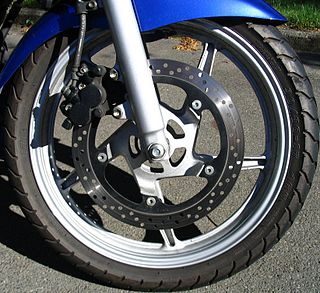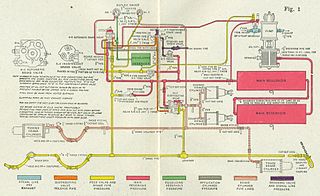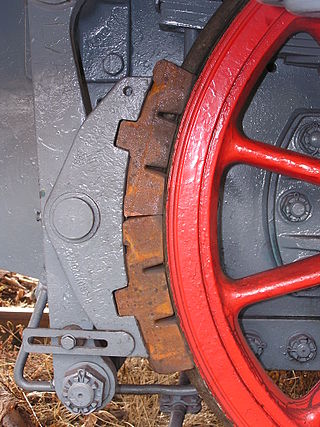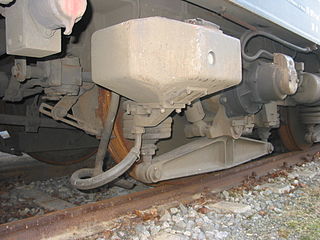
An anti-lock braking system (ABS) is a safety anti-skid braking system used on aircraft and on land vehicles, such as cars, motorcycles, trucks, and buses. ABS operates by preventing the wheels from locking up during braking, thereby maintaining tractive contact with the road surface and allowing the driver to maintain more control over the vehicle.

A brake is a mechanical device that inhibits motion by absorbing energy from a moving system. It is used for slowing or stopping a moving vehicle, wheel, axle, or to prevent its motion, most often accomplished by means of friction.

A railway air brake is a railway brake power braking system with compressed air as the operating medium. Modern trains rely upon a fail-safe air brake system that is based upon a design patented by George Westinghouse on April 13, 1869. The Westinghouse Air Brake Company was subsequently organized to manufacture and sell Westinghouse's invention. In various forms, it has been nearly universally adopted.

A tachometer is an instrument measuring the rotation speed of a shaft or disk, as in a motor or other machine. The device usually displays the revolutions per minute (RPM) on a calibrated analogue dial, but digital displays are increasingly common.

Regenerative braking is an energy recovery mechanism that slows down a moving vehicle or object by converting its kinetic energy or potential energy into a form that can be either used immediately or stored until needed.
Rail transport terms are a form of technical terminology applied to railways. Although many terms are uniform across different nations and companies, they are by no means universal, with differences often originating from parallel development of rail transport systems in different parts of the world, and in the national origins of the engineers and managers who built the inaugural rail infrastructure. An example is the term railroad, used in North America, and railway, generally used in English-speaking countries outside North America and by the International Union of Railways. In English-speaking countries outside the United Kingdom, a mixture of US and UK terms may exist.

On trains, the expression emergency brake has several meanings:

Main components found on a typical steam locomotive include:

Electronic brakeforce distribution or electronic brakeforce limitation (EBL) is an automobile brake technology that automatically varies the amount of force applied to each of a vehicle's wheels, based on road conditions, speed, loading, etc, thus providing intelligent control of both brake balance and overall brake force. Always coupled with anti-lock braking systems (ABS), EBD can apply more or less braking pressure to each wheel in order to maximize stopping power whilst maintaining vehicular control. Typically, the front end carries more weight and EBD distributes less braking pressure to the rear brakes so the rear brakes do not lock up and cause a skid. In some systems, EBD distributes more braking pressure at the rear brakes during initial brake application before the effects of weight transfer become apparent.

A railway brake is a type of brake used on the cars of railway trains to enable deceleration, control acceleration (downhill) or to keep them immobile when parked. While the basic principle is similar to that on road vehicle usage, operational features are more complex because of the need to control multiple linked carriages and to be effective on vehicles left without a prime mover. Clasp brakes are one type of brakes historically used on trains.

A punch press is a type of machine press used to cut holes in material. It can be small and manually operated and hold one simple die set, or be very large, CNC operated, with a multi-station turret and hold a much larger and complex die set.

An adhesion railway relies on adhesion traction to move the train, and is the most widespread and common type of railway in the world. Adhesion traction is the friction between the drive wheels and the steel rail. Since the vast majority of railways are adhesion railways, the term adhesion railway is used only when it is necessary to distinguish adhesion railways from railways moved by other means, such as by a stationary engine pulling on a cable attached to the cars or by a pinion meshing with a rack.
A wheel speed sensor (WSS) or vehicle speed sensor (VSS) is a type of tachometer. It is a sender device used for reading the speed of a vehicle's wheel rotation. It usually consists of a toothed ring and pickup.

The Learjet 25 is an American ten-seat, twin-engine, high-speed business jet aircraft manufactured by Learjet. It is a stretched version of the Learjet 24.

A sandbox is a container on most locomotives, multiple units and trams that holds sand, which is dropped on the rail in front of the driving wheels in wet and slippery conditions and on steep grades to improve traction.

The FS E.636 is a class of Italian articulated electric locomotives. They were introduced in the course of the 1940s until the 1960s, and have been decommissioned since 2006. They have been one of the most numerous Italian locomotive groups, and have been widely employed during their long career, hauling every type of train, ranging from freight to long range passenger services. Their introduction also saw the employment of some revolutionary design concepts, such as the articulated carbody and the three bogies scheme.

Slippery rail, or low railhead adhesion, is a condition of railways (railroads) where contamination of the railhead reduces the traction between the wheel and the rail. This can lead to wheelslip when the train is taking power, and wheelslide when the train is braking. One common cause of contamination is fallen leaves that adhere to the railhead of railway tracks. The condition results in significant reduction in friction between train wheels and rails, and in extreme cases can render the track temporarily unusable. In Britain, the situation is colloquially referred to as "leaves on the line".
The electro-pneumatic brake system on British mainline railway trains was introduced in 1950 and remains the primary braking system for multiple units in service today, although London Transport underground trains had been fitted with EP brakes since the 1920s. The Southern Region of British Railways operated a self-contained fleet of electric multiple units for suburban and middle-distance passenger trains. From 1950, an expansion of the fleet was undertaken and the new build adopted a braking system that was novel in the UK, the electro-pneumatic brake in which compressed air brake operation was controlled electrically by the driver. This was a considerable and successful technical advance, enabling a quicker and more sensitive response to the driver's operation of brake controls.
Wheel slide protection and wheel slip protection are railway terms used to describe automatic systems used to detect and prevent wheel-slide during braking or wheel-slip during acceleration. This is analogous to ABS and traction control systems used on motor vehicles. It is particularly important in slippery rail conditions.
The 1001 class were a class of ten diesel-electric locomotive built by English Electric and Vulcan Foundry in 1955 for Nigerian Railways along with fourteen for the Gold Coast Railways as their 1000 class. Construction and layout was a very similar to the earlier NZR De class.















